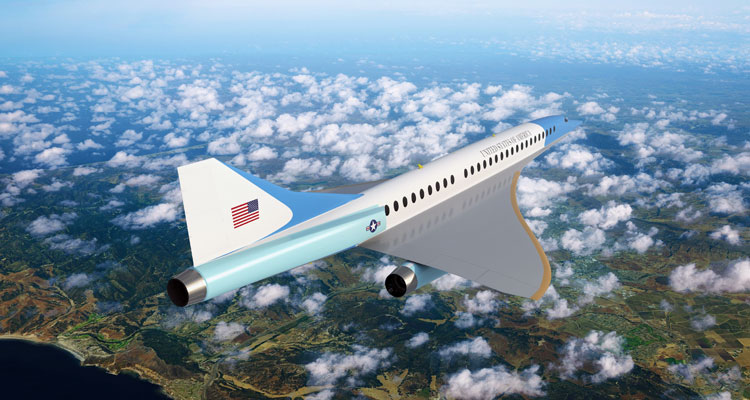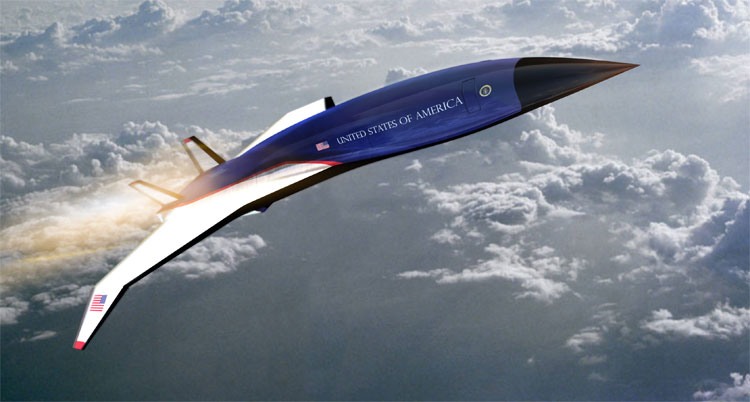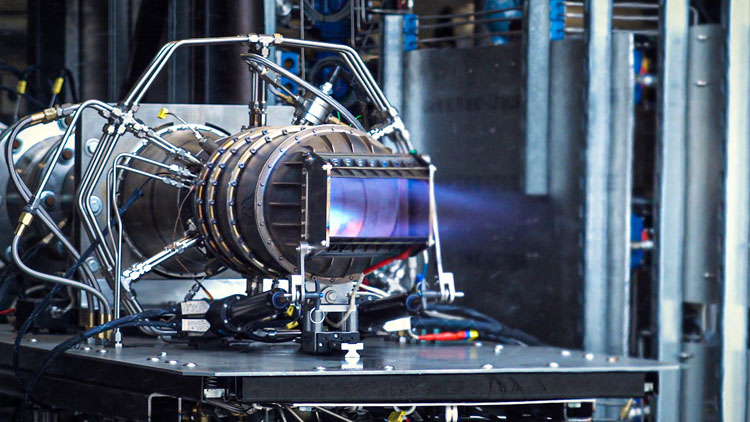INDIAN ARMED FORCES CHIEFS ON
OUR RELENTLESS AND FOCUSED PUBLISHING EFFORTS

SP Guide Publications puts forth a well compiled articulation of issues, pursuits and accomplishments of the Indian Army, over the years

I am confident that SP Guide Publications would continue to inform, inspire and influence.

My compliments to SP Guide Publications for informative and credible reportage on contemporary aerospace issues over the past six decades.
- Prime Minister witnesses 'Bharat Shakti' – a Tri-Services Firing and Manoeuvre Exercise in Pokhran, Rajasthan
- Interim Defence Budget 2024-25 — An Analysis
- Union Defence budget 2024
- Prime Minister Modi Commemorates Indian Navy Day in a Grand Ceremony
- Prime Minister Modi Flies in the LCA Tejas
- New Chapter in India-Italy Defence Ties
- Airpower beyond Boundaries
U.S. Air Force One gearing up for an unmatched speed
Boom Supersonic, Exosonic and Hermeus have been awarded separate contracts by the U.S. Air Force’s Presidential and Executive Airlift Directorate.

The United States (U.S.) Air Force is certainly looking at a faster commute option as it opens up the way for sonic aircraft. The U.S. Air Force’s Presidential and Executive Airlift Directorate recently awarded separate contracts to American manufacturer Boom Supersonic, and start-ups Exosonic and Hermeus to develop executive transports that could be used as Air Force One.
The Presidential and Executive Airlift Directorate manages US government executive transport aircraft, such as the VC-25A, a heavily-modified Boeing 747-200B that is popularly known by its call sign ‘Air Force One’ when the President of the USA flies aboard.
Boom Supersonic, an aerospace company building the world’s fastest commercial airliner announced on September 8, 2020 that the company has been awarded a contract by the Air Force under its program meant to help fund innovations with future Air Force applications. The contract will fund explorations of an Overture, a 45-seat Mach 2.2 airliner, configuration designed for Air Force executive transport. The Department of Defense and the Air Force manage all air transport for executive branch top leadership, including Air Force One, the company reported.
Blake Scholl, Boom founder and CEO said, “Supersonic flight brings people together, whether for work, family or global diplomacy. By cutting travel times we make it possible for U.S. diplomats and executive leaders to connect more frequently in person, meeting challenges and defusing potential crises with a personal touch.
Blake Scholl, Boom founder and CEO said, “Supersonic flight brings people together, whether for work, family or global diplomacy. By cutting travel times we make it possible for U.S. diplomats and executive leaders to connect more frequently in person, meeting challenges and defusing potential crises with a personal touch. We’re so proud to help envision a new way for the Air Force to provide transport for critical government activities.”
Overture offers the Air Force a unique combination of passenger capacity, speed, and enough space and power to accommodate the requirements of necessary mission systems. Not only that, the aircraft can also be configured for multiple cabin zones, affording a layout with as much privacy as necessary. Boom is designing Overture to comply with stringent Federal Aviation Administration (FAA) airworthiness and production regulations, and the aircraft will be fully adaptable to meet specific requirements for a variety of military end users.

“The United States Air Force is constantly looking for technological opportunities to disrupt the balance of our adversaries. Boom is an example of the American ingenuity that drives the economy forward through technological advances. We are extremely excited to team with them as we work to shrink the world and transform the future of executive airlift,” said Brigadier General Ryan Britton, Program Executive Officer for Presidential & Executive Airlift Directorate.
In addition to its potential for executive transport, Overture could be adapted to satisfy other Air Force and broader Department of Defense mission requirements. Overture could also become part of the Civil Reserve Air Fleet (CRAF), enabling humanitarian and other critical airlifts in half the time, Boom reported.
Boom Supersonic is redefining commercial flight by bringing supersonic flight back to the skies with Overture. Founded in 2014, Boom is the first commercial airplane manufacturer to commit to a carbon-neutral flight test program and to build sustainability into its entire aircraft program.
“The United States Air Force is constantly looking for technological opportunities to disrupt the balance of our adversaries. Transporting key decision makers and teams around the world in half the time can be the difference between success and failure,” said Brigadier General Ryan Britton, Program Executive Officer for Presidential & Executive Airlift Directorate.
Exosonic, a low-boom supersonic aircraft manufacturer, has also partnered with the U.S. Air Force's Presidential and Executive Airlift Directorate to develop a supersonic executive transport, the start-up confirmed in a press release on September 1, 2020. Exosonic stated that its aircraft can provide top US leaders and diplomats rapid transportation around the world to meet with world leaders or react to developing situations on the ground. By utilising Exosonic's boom softening techniques, the passengers can travel overland and overwater at supersonic speeds, pending regulations, to roughly reduce their cruise times in half compared to existing aircraft.
“The Presidential and Executive Airlift Directorate is extremely excited to team with Exosonic on our quest to transform the future of executive airlift. As always, we are proud to be leading the charge to deliver cutting-edge technology to the world,” said Britton.

He also added that transporting key decision makers and teams around the world in half the time can be the difference between success and failure. “Exosonic is a key player in getting us there. By teaming with industry, we are proving the United States Air Force can deliver technology leaps while maximising return on taxpayer investment.”
PE’s contract, sponsored by the Air Force Research Lab, will support Exosonic’s efforts to develop and modify the company’s commercial supersonic airliner to serve as an executive transport vehicle. These modifications will include reconfiguring the aircraft cabin to include the required accommodations, communications equipment, and security measures that allow US leaders and their guests to work and rest onboard the aircraft.
“The future for global rapid passenger travel is low-boom supersonic flight. Low boom allows travelers to fly at supersonic speeds without generating disruptive booms for those on the ground. Exosonic is excited to win this contract as it represents not only commercial but government promise for low-boom supersonic travel,” said Norris Tie, CEO of Exosonic.
“The future for global rapid passenger travel is low-boom supersonic flight. Low boom allows travelers to fly at supersonic speeds without generating disruptive booms for those on the ground. Exosonic is excited to win this contract as it represents not only commercial but government promise for low-boom supersonic travel,” said Norris Tie, CEO of Exosonic.
In partnership with the U.S. Air Force, Exosonic stated that it will continue to develop technology that will not only advance the critical missions of our nation but also enhance our commercial abilities to bring quiet supersonic travel to all. Exosonic is an early-stage company developing a Mach 1.8, 5000 nmi range, 70 passenger supersonic airliner to fly overland with a muted boom.
The aerospace company developing Mach 5 commercial aircraft, Hermeus Corporation, also received the partnership with the U.S. Air Force and the Presidential and Executive Airlift Directorate to work towards hypersonic travel for the Department of Defense. This award comes under an Other Transaction For Prototype Agreement Direct to Phase II contract through AFWERX after Hermeus successfully tested a Mach 5 engine prototype in February 2020, the company stated in a press release in August 6, 2020.

The effort is focused on rapidly assessing modifications to Hermeus Mach 5 aircraft to support the Presidential and Executive Airlift fleet. Early integration of unique Air Force requirements for high-speed mobility and evaluation of interfaces between high-speed aircraft and existing communications, airport, and air traffic control infrastructure lays the groundwork for a seamless transition to service. Additionally, Hermeus will prepare test plans to reduce technical risk associated with these modifications to support Air Force requirements.
Commenting on the program, Britton said, "Leaps in capability are vital as we work to complicate the calculus of our adversaries. By leveraging commercial investment to drive new technologies into the Air Force, we are able to maximise our payback on Department of Defense investments. The Presidential and Executive Airlift Directorate is proud to support Hermeus in making this game-changing capability a reality as we look to recapitalise the fleet in the future."
"Using our pre-cooler technology, we've taken an off-the-shelf gas turbine engine and operated it at flight speed conditions faster than the famed SR-71. In addition, we've pushed the ramjet mode to Mach 4-5 conditions, demonstrating full-range hypersonic air-breathing propulsion capability," said Glenn Case, Hermeus’ CTO.
Preceding the award, the Hermeus team designed from scratch, built, and successfully tested a Mach 5 engine prototype, in nine months. The test campaign both served as risk reduction for Hermeus' turbine-based combined cycle engine architecture and illustrated the team's ability to execute with schedule and funding efficiency. "Using our pre-cooler technology, we've taken an off-the-shelf gas turbine engine and operated it at flight speed conditions faster than the famed SR-71. In addition, we've pushed the ramjet mode to Mach 4-5 conditions, demonstrating full-range hypersonic air-breathing propulsion capability," said Glenn Case, Hermeus’ CTO.
Hermeus believes that at Mach 5 - over 3000 miles per hour - flight times from New York to London will be 90 minutes rather than 7 hours. High-speed aircraft offer disruptive differentiation where the main metric is speed, rather than plush seats, which has historically resulted in economic expansion. Mach 5 aircraft have the potential to create an additional two trillion dollars of global economic growth per year.
Boom plans to fly Overture in 2025, with certification and service entry expected in 2027. Exosonic and Hermeus have not yet provided development timelines for their faster-than-sound airplanes.





